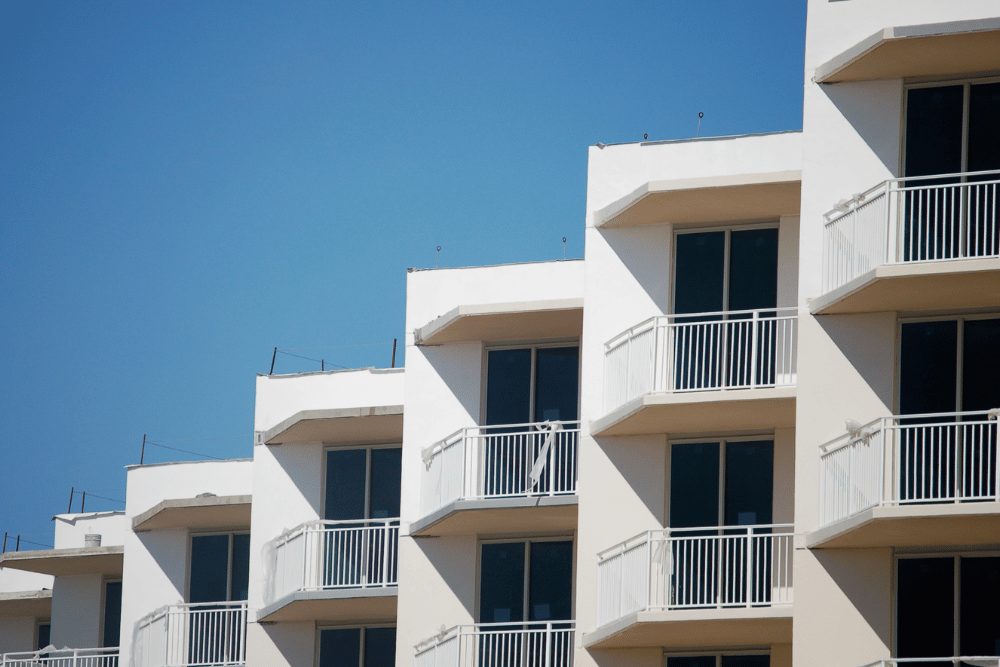Live Surveillance vs. Basic Cameras: Multifamily Properties

For multi-family property managers, security is more than an amenity—it’s also a legal obligation. Security cameras can help protect your property, but technological advancements have expanded your options. It can be hard to choose. Is CCTV enough? What about simple DIY cameras from mass-market producers, like Ring or Nest? In reality, the best cameras for multifamily properties combine smart technology with live surveillance.
Live Surveillance Is More than a Camera
First, we have to draw a distinction between types of camera systems. Deep Sentinel’s multi-family residential security solutions use cameras, but the hardware is only the beginning.
The core of the system is a local smart hub. AI analyzes each frame of footage instantly and separates potential threats like humans from harmless motion, like wildlife or passing cars. When the system detects someone on your property, the hub securely streams the live feed to Deep Sentinel’s guard team.
A LiveSentinel guard analyzes the situation to decide whether an intervention is necessary. Within seconds, the guard intervenes directly using the camera’s 2-way audio and built-in siren. Often, a “hello” is enough to send suspects on their way. In the event of a crime, the guards call local law enforcement and the property owner. The police take these calls seriously because the guards report a “verified” active situation including suspect description and behavior.
So, while a basic camera might record a crime, only live surveillance by professional guards can prevent a crime.
Surveillance vs. Basic Cameras for Multifamily: Overview
| Deep Sentinel Live Surveillance | Traditional Security Camera | |
| Engagement | Live guards engage with suspects Can prevent issues and verify crimes |
No one contacts suspects on your behalf Passively records the property |
| Management | Hands-off Doesn’t require user input |
Hands-on User must verify, intervene, etc. |
| Speed | 10 seconds to intervention 30 seconds to police contact Crime verification gets a fast police response |
System alerts user in 10-30 seconds or more (if at all) Response time depends on user |
| Accuracy | AI with human verification No false alarms |
Most record everything User must sort threats from false alarms |
| Effectiveness | Prevents crimes outside the property Proactive Protection |
Records crimes after break-in Only useful after the criminal is gone |
Deep Dive: Major Differentiators
What sets Deep Sentinel apart from CCTV and low-end DIY cameras for multifamily properties? Let’s look closer.
Engagement
Typical security cameras are the very definition of passive security. A crime occurs at your complex, the camera records the crime, and you play the footage back later to figure out what happened. No one intervenes while the criminal does their misdeed. Your best hope is that the recording is clear and compelling enough to use in court.
Live surveillance is an entirely different beast: active security. With Deep Sentinel, guards can see a real-time feed of your property. At any moment, they can jump in, speak with anyone on camera, set off an alarm, and even call the cops. With real eyes and ears on the scene, they can de-escalate dangerous situations and confirm details of any criminal activity before involving law enforcement.
(You’ll still have a recording, but wouldn’t you rather stop a crime than record it?)
Management
Multifamily properties are complex businesses with lots of moving parts. The last thing property managers need is another set of tasks on their plates.
Cameras that passively record might be hands-off, but as we’ve already discussed, they also can’t stop crime. So let’s say you get a camera with motion detection and live notifications. Who’s watching out for these alerts? And who’s filtering through the feeds to find trouble and intervene? It’s probably the property manager (lots of work) or a hired security officer (lots of money). Either way, there’s an overabundance of footage to watch, process, and react to.
By comparison, Deep Sentinel truly is hands-off. Users are welcome to look at system footage, but the LiveSentinel guards can handle the entire process without bothering the property manager. They’ll even call the cops without wasting time trying to contact the system owner, which is what most “monitoring” companies do. And AI filters out harmless motion before the system raises an alert, so you don’t have to worry about endless notifications. It’s multifamily property protection you never need to worry about.
Speed
If you choose self-monitoring for your property’s cameras, the time it takes to respond to a crisis is up to the person doing the monitoring. A motion-detection camera will likely alert you in about 10 seconds, maybe more. How long does it take to notice an alert, pull out a phone, and hoof it over to that part of the property? Probably too long.
Deep Sentinel speeds up the process, offering real-time intervention. When motion awakes the camera, AI processes the feed instantly to detect threats. In the case of suspicious activity, a guard is watching and reacting within 10 seconds. And, if there’s a crime, the guard will call the police within 30 seconds. Law enforcement agencies prioritize verified crimes, so an officer will be onsite that much sooner. No other security provider promises a faster response.
Accuracy
Plenty of security cameras for multifamily properties, especially older models, simply record everything. Then it’s up to you to sort through the footage.
Even newer, nicer cameras with motion sensors aren’t much better. These record and possibly send notifications any time anything moves in front of the camera. Multifamily properties are busy places, with plenty of people, pets, cars, and more moving about. Do you want a system that goes on high alert every time a critter passes by? False alarms are annoying and unhelpful.
The answer to this problem is Deep Sentinel’s combination of AI threat detection and human verification. The system’s integrated AI processor dismisses non-human motion. Then, a live guard applies human intellect and years of experience to determine whether the situation warrants further action. With this multi-layered solution, Deep Sentinel has eliminated false alarms for good.
Effectiveness
Can traditional security cameras protect your property? Between the superfluous footage and the slow, painstaking process of going through footage, it’s pretty clear that these cameras aren’t your best crime-stopping tool. A visible camera might discourage bad behavior, and recordings can certainly be useful evidence for catching the culprit, so these systems certainly have merit. But more effective options are available for property owners who truly care about preventing crime at their apartment or condo complex.
With Deep Sentinel, you’ll still get the benefits of visible cameras and clear, crisp recordings. But you also have a team in your corner that’s ready to sound an alarm and call the police before a crook even reaches the front door. Comprehensive, powerful security means better tenant appeal, fewer losses, decreased legal risks, and more.
Wouldn’t you rather have the best?
How Most Security Cameras for Multifamily Buildings Fall Short
Most cameras are reactive, not proactive. Because they’re primarily used as recording devices, they’re only useful once a criminal has already struck your property. They cannot prevent crime—they can only react to it after the fact.
The “simple” solution is watching the camera feeds to catch threats as they arise. But monitoring your own cameras is a lot of work. If you have one camera at each entrance, plus in the lobby, by the pool, near the mail room… it’s a lot to watch, and a threat can easily slip by unnoticed. That’s not to mention all the false alarms from motion-activated cameras that go on high alert every time a tenant lets out the dog.
When it comes down to it, traditional cameras offer weaker protection than a live monitored system can. Without features like live intervention or integrated alarms, cameras alone may not offer adequate protection, which opens you up to liability issues.
A Possible Use Case for Simple Cameras: Individual Units
Basic cameras aren’t perfect, but they have their uses, too.
Deep Sentinel systems protect your multifamily property from the outside in. The guards can stop common crimes like loitering, trespassing, and vandalism in common areas. But what about your tenants’ living spaces? Due to surveillance camera laws and the nature of multifamily living, you can’t (and shouldn’t) put cameras inside each apartment or condo.
If your tenants desire an extra level of security within their units, encouraging them to install basic security cameras might be a solid solution. That way, at least they’ll have video evidence of any trouble that arises in the privacy of their own space. You might even consider reimbursing tenants for these devices.
Smarter Cameras for Multifamily Properties: Deep Sentinel
Cameras are a good idea for your multifamily property. Deep Sentinel cameras are an even better idea.
Get all the perks of traditional apartment complex security cameras with the expanded protection capacity that AI and live intervention bring to the table. With better security, you’ll be able to attract and keep high-quality tenants and give them the protection they need and deserve.
Interested in Deep Sentinel’s multi-family residential security solutions? Call 833.983.6006 for your free security consultation.
More Resources
Need a Solution that Prevents Crime?
Deep Sentinel is the only security technology that delivers the experience of a personal guard on every customer’s home and business. Visit deepsentinel.com/business or call 833-983-6006

